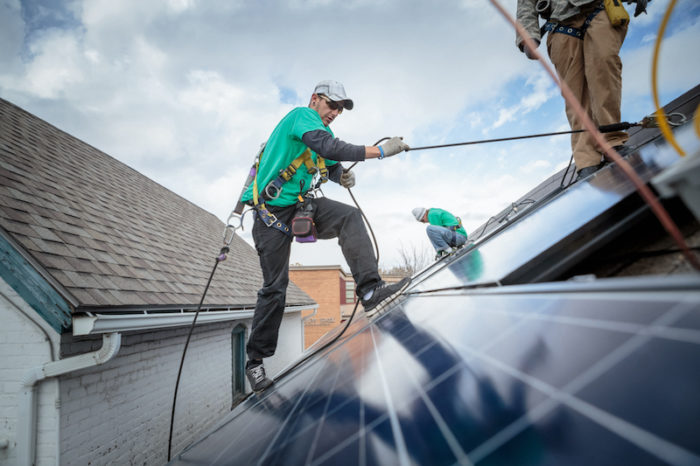SELC’s leading energy efficiency expert says Duke’s proposed N.C. carbon plan needs work
Like many communities throughout the South, North Carolinians are increasingly feeling the impacts of climate change from flooding, slower storms that drop more rain, rising sea levels that harm coastal areas, and warmer and more humid days and nights. There’s no longer time to waste when it comes to taking action with viable solutions to ensure a livable climate.
We talked to Senior Attorney Gudrun Thompson, the Southern Environmental Law Center’s Energy Efficiency Regional Leader out of our Chapel Hill office, about Duke Energy’s proposal to reduce carbon emissions in North Carolina, and the necessary improvements to the plan to meet carbon-reduction targets on time in a cleaner and more cost-effective way.
What do energy advocates want to see the North Carolina Utilities Commission focus on or give more weight to in a final plan?
What we want to see in the final carbon reduction plan that the commission will issue at the end of the year is a no-regrets pathway relying on clean, cost-effective resources like energy efficiency, solar, wind, and battery storage, and rapidly phasing out fossil fuels. Also, not building any new gas at a time when we can’t afford to lock ourselves into decades more of dependence on fossil fuels.
Why is it important to center renewable energy options and energy efficiency in reaching carbon reduction goals?

Energy efficiency is the cleanest and cheapest carbon-free resource that we have available. It goes without saying that the cheapest kilowatt of energy you can get is the one that you don’t have to generate with a power plant. Solar is also a carbon- and fuel-free resource that is abundant in the sunny South and generates jobs in our communities.
We’re seeing a lot of volatility and huge spikes in the gas market, and that really puts customers’ pocketbooks at risk.
How would Duke’s proposal—which relies heavily on new gas plants in the short term, and unproven new nuclear and zero-carbon hydrogen technologies—undermine North Carolina’s progress in meeting the carbon reduction target and timeline?
Duke’s proposal includes four different options, three of which would not actually meet the state’s 70 percent reduction requirement by 2030. Right out of the gate, Duke is presenting proposed portfolios that are designed to fail, so that’s a problem. We’ve also already talked a little bit about how locking in gas at a time when we need to be rapidly phasing out fossil fuels is just the wrong way to go.
In the very near term, science is telling us that we need to slash carbon pollution quickly. There’s no time to waste. So waiting until after 2030 to be making those cuts is not right for the climate.
It’s also not necessary to build new gas in order to phase out coal. Instead, we can phase out coal and replace it with a portfolio of clean renewable energy like solar, wind, and energy efficiency.
A successful carbon plan here can show other states in the Southeast that they can launch a similar effort that will benefit their economies.
Senior Attorney Gudrun Thompson
How would Duke’s proposal negatively impact customers?
Duke’s proposal has a higher price tag than the alternative portfolio we’re proposing. The forecast of the long-term cost is lower with the cleaner energy portfolio.
How does the recent U.S. Supreme Court ruling on EPA’s ability to regulate carbon emissions put state action like North Carolina’s carbon plan in perspective, especially compared to other Southern states without mandatory reduction goals?
It just really underscores the need for states to take the lead in tackling climate change and that North Carolina, under the leadership of Governor Roy Cooper, has emerged as a national leader among states that aren’t just talking about reducing carbon pollution, but doing something about it. North Carolina is also a great example of a state that’s leading in the absence of federal leadership, but we can’t go it alone. It’s going to be important for states and localities to work together, and that’s why we think the possibility of North Carolina joining the Regional Greenhouse Gas Initiative is so exciting. RGGI is a cooperative regional effort that has proven to deliver carbon reductions. Once you have enough states participating, it really can make a difference. We think joining RGGI should be part of the strategy to achieve carbon reduction requirements and should be part of the carbon plan.
How can this utility commission proceeding provide a framework for success for the Southeast?
Our electric utilities have a lot in common across SELC’s six-state region in terms of reliance on coal, plans to double down on fossil fuels by building new gas capacity, and not enough renewables or energy efficiency despite increasing customer demand for cleaner options. The North Carolina carbon plan could really serve as a model for utilities in other Southern states that have similar systems in terms of power plants and transmission grids, similar climates, and demographics.
A successful carbon plan here can show other states in the Southeast that they can launch a similar effort that will benefit their economies.
What actions do you hope the commission will take in this proceeding?
We’re going to ask the commission to develop and issue a plan that relies on clean energy resources like efficiency, solar, wind, and storage, and rapidly phases out aging, polluting coal plants without building any new gas.
